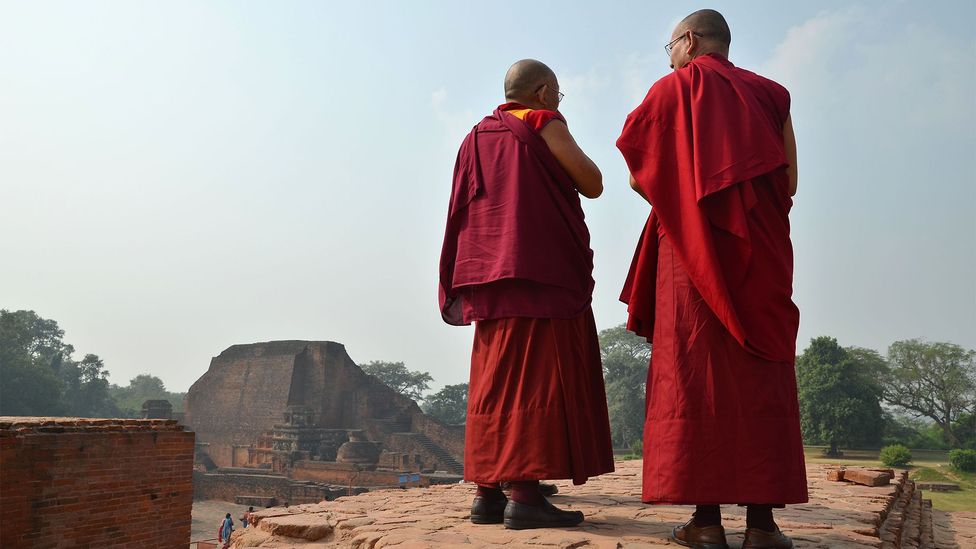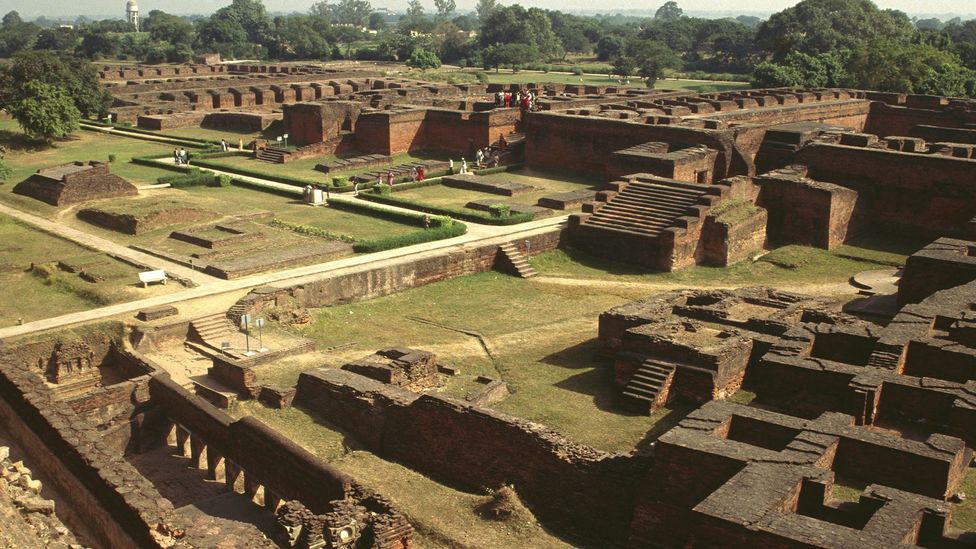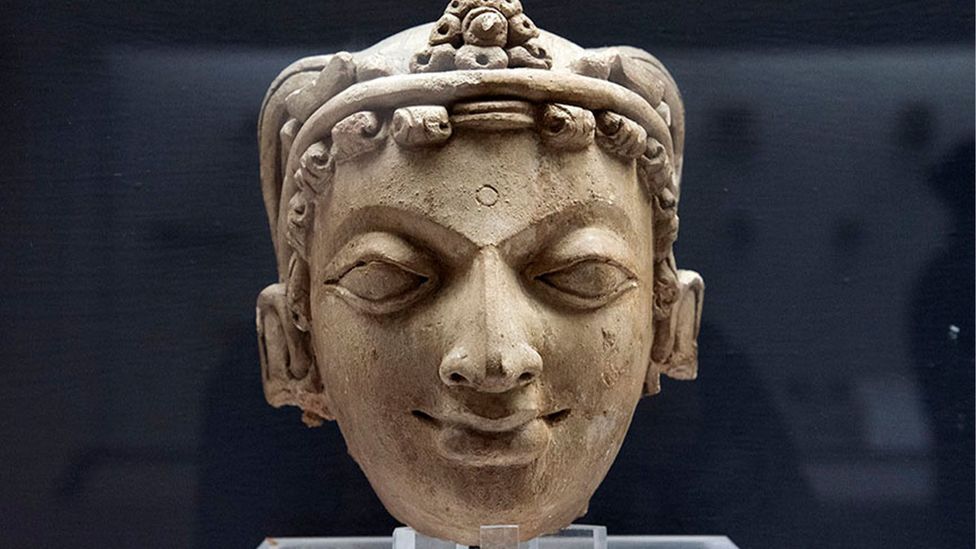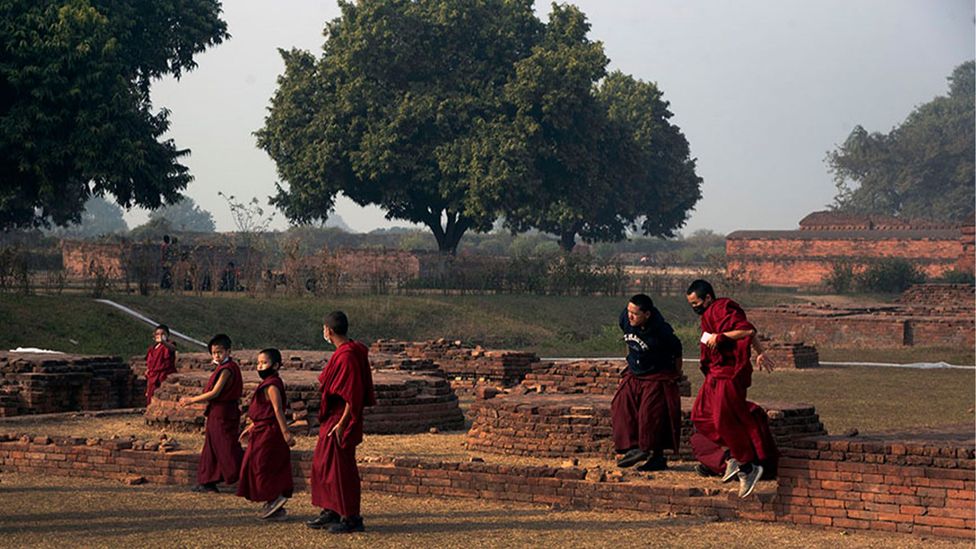Sugato Mukherjee
The winter morning was cloaked in thick fog. Our car swerved past horse-drawn carriages, a mode of transport still popular in the rural reaches of the eastern Indian state of Bihar, the trotting horses and turbaned coachmen looking like shadowy apparitions in the pearly-white mist.
After spending a night in the town of Bodhgaya, the ancient settlement where Lord Buddha is said to have attained enlightenment, I set out that morning for Nalanda, whose red-brick ruins are all that remain of one of the greatest centres of learning in the ancient world.
Founded in 427 CE, Nalanda is considered the world’s first residential university, a sort of medieval Ivy League institution home to nine million books that attracted 10,000 students from across Eastern and Central Asia. They gathered here to learn medicine, logic, mathematics and – above all – Buddhist principles from some of the era’s most revered scholars. As the Dalai Lama once stated: “The source of all the [Buddhist] knowledge we have, has come from Nalanda.”
Ten thousand students from across Asia came to Nalanda to learn Buddhist principles from some of the era’s most revered scholars (Credit: imageBROKER/Alamy)
In the more-than seven centuries that Nalanda flourished, there was nothing else like it in the world. The monastic university predates the University of Oxford and Europe’s oldest university, Bologna, by more than 500 years. What’s more, Nalanda’s enlightened approach to philosophy and religion would help shape the culture of Asia long after the university ceased to exist.
Interestingly, the monarchs of the Gupta Empire that founded the Buddhist monastic university were devout Hindus, but sympathetic and accepting towards Buddhism and the growing Buddhist intellectual fervour and philosophical writings of the time. The liberal cultural and religious traditions that evolved under their reign would form the core of Nalanda’s multidisciplinary academic curriculum, which blended intellectual Buddhism with a higher knowledge in different fields.
The ancient Indian medical system of Ayurveda, which is rooted in nature-based healing methods, was widely taught at Nalanda and then migrated to other parts of India via alumni. Other Buddhist institutions drew inspiration from the campus’ design of open courtyards enclosed by prayer halls and lecture rooms. And the stucco produced here influenced ecclesiastical art in Thailand, and metal art migrated from here to Tibet and the Malayan peninsula.
But perhaps Nalanda’s most profound and lingering legacy is its achievements in mathematics and astronomy.
Aryabhata, considered the father of Indian mathematics, is speculated to have headed the university in the 6th Century CE. “We believe that Aryabhata was the first to assign zero as a digit, a revolutionary concept, which simplified mathematical computations and helped evolve more complex avenues such as algebra and calculus,” said Anuradha Mitra, a Kolkata-based professor of mathematics. “Without zero, we wouldn’t have computers,” she added. “He also did pioneering works in extracting square and cubic roots, and applications of trigonometrical functions to spherical geometry. He was also the first to attribute radiance of the moon to reflected sunlight.”
This work would profoundly influence the development of mathematics and astronomy in southern India and across the Arabian Peninsula.
The university regularly sent some of its best scholars and professors to places like China, Korea, Japan, Indonesia and Sri Lanka to propagate Buddhist teachings and philosophy. This ancient cultural exchange programme helped spread and shape Buddhism across Asia.
The excavated Unesco site extends for 23 hectares, but is likely a mere fraction of the original campus (Credit: Dinodia Photos/Alamy)
The archaeological remains of Nalanda arenow a Unesco World Heritage site. In the 1190s, the university was destroyed by a marauding troop of invaders led by Turko-Afghan military general Bakhtiyar Khilji, who sought to extinguish the Buddhist centre of knowledge during his conquest of northern and eastern India. The campus was so vast that thefire set on by the attackersis said to have burned for three months. Today, the 23-hectare excavated site is likely a mere fraction of the original campus, but ambling through its multitude of monasteries and temples evokes a feeling of what it must have been like to learn at this fabled place.
I wandered around the porches and porticos of the monasteries and the shrine-chambers of the temples. After slipping through a corridor with lofty, red-brick walls, I arrived at an inner courtyard of a monastery. The cavernous, rectangular space was dominated by a raised stone platform. “This used to be a lecture hall that could sit 300 students. And the platform was the teacher’s podium,” said Kamla Singh, my local guide, who showed me around the ruins. I went into one of the small rooms that lined the courtyard where students from as far away as Afghanistan lived. Two alcoves facing each other were meant to hold oil lamps and personal belongings, and Singh explained that the small, square-shaped hollow near the entrance of the cell served as each student’s personal letterbox.
Like today’s elite universities, admission was tough. Aspiring students needed to engage in a rigorous oral interview with Nalanda’s top professors. Those who got lucky were tutored by an eclectic group of professors from different corners of India and collectively operated under the most revered Buddhist masters of the era, such as Dharmapala and Silabhadra.
The library’s nine million handwritten, palm-leaf manuscripts was the richest repository of Buddhist wisdom in the world, and one ofits three library buildings was described by Tibetan Buddhist scholar Taranatha as a nine-storey building “soaring into the clouds”. Only a handful of those palm-leaf volumes and painted wooden folios survived the fire – carried away by fleeing monks. They can now can be found at Los Angeles County Museum of Art in the US and Yarlung Museum in Tibet.![The Dalai Lama once said: "The source of all the [Buddhist] knowledge we have, has come from Nalanda." (Credit: REY Pictures/Alamy)](https://ychef.files.bbci.co.uk/976x549/p0f3vn4g.jpg)
The Dalai Lama once said: “The source of all the [Buddhist] knowledge we have, has come from Nalanda.” (Credit: REY Pictures/Alamy)
The acclaimed Chinese Buddhist monk and traveller Xuanzang studied and taught at Nalanda. When he returned to China in 645 CE, he carried back a wagonload of 657 Buddhist scriptures from Nalanda. Xuanzang would go on to become one of the world’s most influential Buddhist scholars, and he would translate a portion of these volumes into Chinese to create his life’s treatise, whose central idea was that the whole world is but a representation of the mind. His Japanese disciple, Dosho, would later introduce this doctrine to Japan, and it would spread further into the Sino-Japanese world, where it would remain as a major religion ever since. As a result, Xuanzang has been credited as “the monk who brought Buddhism East“.
In Xuanzang’s description of Nalanda, he had mentioned the Great Stupa – a huge monument constructed in memory of one of Lord Buddha’s chief disciples. I stood in front of the ruins of the imposing structure, shaped like an octagonal pyramid. Open-brick staircases wound their way up to the top of the edifice, also known as the Great Monument. Numerous small shrines and votive stupas dot the paved terrace that runs around the 30m-high temple, which is adorned by beautiful stucco images in the niches of the exterior walls.
“The Great Stupa actually predates the university and was built in the 3rd Century CE by Emperor Ashoka. The structure had been rebuilt and remodelled several times over eight centuries,” said Anjali Nair, a history teacher from Mumbai, whom I had met at the site. “Those votive stupas contain the ashes of the Buddhist monks who had lived and died here, dedicating their entire lives to the university,” she added.
More than eight centuries after its demise, some scholars contest the widely held theory that Nalanda was destroyed because Khilji and his troops felt its teachings competed with Islam. While uprooting Buddhism may have been a driving force behind the attack, one of India’s pioneering archaeologists, HD Sankaliya, wrote in his 1934 book, The University of Nalanda, that the fortress-like appearance of the campus and stories of its wealth were reasons enough for invaders to deem the university a lucrative spot for an attack.
The onsite museum houses more than 13,000 antiquities salvaged during the site’s excavations (Credit: Sugato Mukherjee)
“Yes, it is difficult to assign a definitive reason for the invasion,” said Shankar Sharma, the director of the onsite museum, which displays 350 artefacts of the more-than 13,000 antiquities it houses, which were salvaged during Nalanda excavations, such as stucco sculptures, bronze statuettes of the Buddha, and ivory and bone pieces.
“It was not the first attack on Nalanda, though,” Sharma said, as we strolled through the ruins. “It was attacked by the Huns under Mihirkula in the 5th Century, and again sustained severe damages from an invasion of the Gauda king of Bengal, in the 8th Century.”
While the Huns came to plunder, it is difficult to conclude whether the second attack by the King of Bengal was the result of a growing antagonism between their Shaivite Hindu sect and the Buddhists at the time. On both occasions, the buildings were restored, and the facilities were expanded after the attacks with the help of imperial patronage from the rulers.
“By the time Khilji invaded this sacred temple of learning, Buddhism was on an overall state of decline in India,” Sharma said. “With its internal degeneration, coupled with [the] decline of the Buddhist Pala dynasty that had been patronising the university since the 8th Century CE, the third invasion was the final death blow.”
The ruins of Nalanda remain an important place of pilgrimage and reflection for Buddhists (Credit: Sugato Mukherjee)
Over the next six centuries, Nalanda would gradually sink into oblivion and remain buried, before it was “discovered” by Scottish surveyor Francis Buchanan-Hamilton in 1812, and later identified as the ancient Nalanda University by Sir Alexander Cunningham in 1861.
Standing near a miniature stupa, I watched a small band of young monks clad in crimson robes touring the site before they stopped to gather atop the large plinth of a former temple. The young ascetics sat upright in a meditative repose, their eyes fixed on the Great Monument – a silent homage to a glorious past.
Courtesy: bbc







